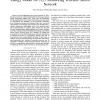Free Online Productivity Tools
i2Speak
i2Symbol
i2OCR
iTex2Img
iWeb2Print
iWeb2Shot
i2Type
iPdf2Split
iPdf2Merge
i2Bopomofo
i2Arabic
i2Style
i2Image
i2PDF
iLatex2Rtf
Sci2ools
CSE
2008
IEEE
2008
IEEE
Energy Model for H2S Monitoring Wireless Sensor Network
Abstract— Several applications have been proposed for Wireless sensor networks. These include habitat monitoring, structural health monitoring, pipeline (gas, water, and oil) monitoring, precision agriculture, active volcano monitoring, and many more. To demonstrate the feasibility of the proposals, researchers have developed prototypes and deployed them into real-world environments. Even though each prototype was developed for a specific sensing task, interestingly most of the networks share several characteristics in common. Some of these are: The need for time synchronisation, high sampling rate of short duration, multi-hop routing, periodical sampling and sleeping, and medium access control. Whereas there are a plethora of existing and proposed protocols to address these issues, each prototype chooses to address the issues in a proprietary manner. The lack of reuse practice poses a generalisation problem. In this paper we motivate toxic gas detection during oil exploration and r...
Active Volcano Monitoring | Computer Science And Engineering | CSE 2008 | Structural Health Monitoring | Wireless Sensor Network |
| Added | 29 May 2010 |
| Updated | 29 May 2010 |
| Type | Conference |
| Year | 2008 |
| Where | CSE |
| Authors | Xiaojuan Chao, Waltenegus Dargie, Lin Guan |
Comments (0)

